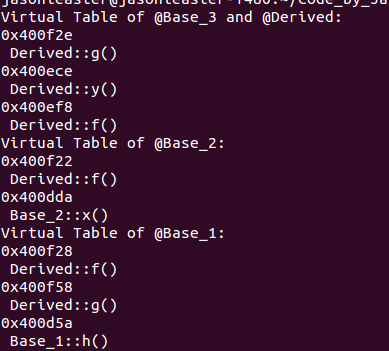关于C++多重继承的时候虚函数覆盖的问题
2015-06-14 13:42
501 查看
问题描述:
下面的代码试图去通过运行时程序分析和验证C++的虚表实现机制。
下面的代码在探究多重继承情况下,虚表的情况
copy代码, g++编译,观察输出结果,会发现,在派生类@Derived 中重新定义了虚函数 virtual void f(void)
这样以来,基类的函数实现就会被覆盖。通过虚表调用函数f,都会调用重新定义的这个,而不是旧的(实质是指针的覆盖)。
但是在我测试的时候出现了一个很奇葩的问题
观察输出,你会看到这里Derived::f()的函数实现的地址,居然有三个不同的地址,我都惊呆了。。。
理论上,实例化一个Derived::f()函数就可以了。把这个实例化的函数首地址指针覆盖到对应的虚表中即可。
但是这里居然出现了三个不同的Derived::f() (最起码看起来是不一样的。他们的地址不同额。。。)
表示很困惑。。。


为什么居然会有三个不同的Derived::f(),故意的嘛?
下面的代码试图去通过运行时程序分析和验证C++的虚表实现机制。
下面的代码在探究多重继承情况下,虚表的情况
copy代码, g++编译,观察输出结果,会发现,在派生类@Derived 中重新定义了虚函数 virtual void f(void)
这样以来,基类的函数实现就会被覆盖。通过虚表调用函数f,都会调用重新定义的这个,而不是旧的(实质是指针的覆盖)。
但是在我测试的时候出现了一个很奇葩的问题
观察输出,你会看到这里Derived::f()的函数实现的地址,居然有三个不同的地址,我都惊呆了。。。
理论上,实例化一个Derived::f()函数就可以了。把这个实例化的函数首地址指针覆盖到对应的虚表中即可。
但是这里居然出现了三个不同的Derived::f() (最起码看起来是不一样的。他们的地址不同额。。。)
表示很困惑。。。


为什么居然会有三个不同的Derived::f(),故意的嘛?
/*******************************************************************
Programmer : EOF
Date : 2015.06.13
File : virtual_function_for_multiple_inheritance.cpp
E-mail : jasonleaster@gmail.com
******************************************************************/
#include <iostream>
using namespace std;
typedef void (*FUN) (void);
class Base_1
{
public:
int num;
Base_1():prv_data(100), num(100) { }
virtual void f(void){ cout << " Base_1::f()" << endl; }
virtual void g(void){ cout << " Base_1::g()" << endl; }
virtual void h(void){ cout << " Base_1::h()" << endl; }
private:
/*
Private Data
*/
int prv_data;
};
class Base_2
{
public:
int num;
Base_2():prv_data(200), num(200) { }
virtual void f(void){ cout << " Base_2::f()" << endl; }
virtual void x(void){ cout << " Base_2::x()" << endl; }
private:
/*
Private Data
*/
int prv_data;
};
class Base_3
{
public:
int num;
Base_3():prv_data(300), num(300) { }
virtual void g(void){ cout << " Base_3::g()" << endl; }
private:
/*
Private Data
*/
int prv_data;
};
class Derived : public Base_3, public Base_2, public Base_1
{
public:
int num;
Derived():num(42), prv_data(42) { }
virtual void y(void){ cout << " Derived::y()" << endl; }
/*
Here we re-implement the virtual function @f().
Compiler will rewrite the virtual table
*/
virtual void f(void){ cout << " Derived::f()" << endl; }
virtual void g(void){ cout << " Derived::g()" << endl; }
private:
int prv_data;
};
template<class T>
unsigned long* get_element(T &obj, int offset = 0, int vprt_offset = 0)
{
return ((unsigned long*)*((unsigned long*)(&obj) + vprt_offset)) + offset ;
}
int main()
{
Derived d;
cout << "Virtual Table of @Base_3 and @Derived:" << endl;
cout << (int*)*get_element(d, 0, 0) << endl;
((FUN)(*get_element(d, 0, 0))) ();
cout << (int*)*get_element(d, 1, 0) << endl;
((FUN)(*get_element(d, 1, 0))) ();
cout << (int*)*get_element(d, 2, 0) << endl;
((FUN)(*get_element(d, 2, 0))) ();
cout << "Virtual Table of @Base_2:" << endl;
cout << (int*)*get_element(d, 0, sizeof(Base_3)/8) << endl;
((FUN)(*get_element(d, 0, sizeof(Base_3)/8))) ();
cout << (int*)*get_element(d, 1, sizeof(Base_3)/8) << endl;
((FUN)(*get_element(d, 1, sizeof(Base_3)/8))) ();
cout << "Virtual Table of @Base_1:" << endl;
cout << (int*)*get_element(d, 0, (sizeof(Base_3) + sizeof(Base_2))/8) << endl;
((FUN)(*get_element(d, 0, (sizeof(Base_3) + sizeof(Base_2))/8))) ();
cout << (int*)*get_element(d, 1, (sizeof(Base_3) + sizeof(Base_2))/8) << endl;
((FUN)(*get_element(d, 1, (sizeof(Base_3) + sizeof(Base_2))/8))) ();
cout << (int*)*get_element(d, 2, (sizeof(Base_3) + sizeof(Base_2))/8) << endl;
((FUN)(*get_element(d, 2, (sizeof(Base_3) + sizeof(Base_2))/8))) ();
return 0;
}
相关文章推荐
- C/C++中字符串的输入问题
- HDU-1049-Climbing Worm(C++ && 编程初学者的题......)
- 一步步将vim改造成C/C++开发环境(IDE)
- 【Search in Rotated Sorted Array II 】cpp
- C/C++中##与#的使用
- c语言中如何实现可变参数
- C语言中通过按位与求奇偶源码
- 【leetcode c++】14Longest Common Prefix
- _int64 C语言中怎么用
- C++ 虚析构函数 分析
- C/C++程序员面试易错题
- C++精确计算代码执行时间精度微秒级
- c++ 模板联系4
- c++ 模板联系4
- c++ 模板练习2
- C++ 一般模板友元关系
- C++ 一般模板友元关系
- c++ 模板练习2
- C++ 模板练习1
- C++ 模板练习1
